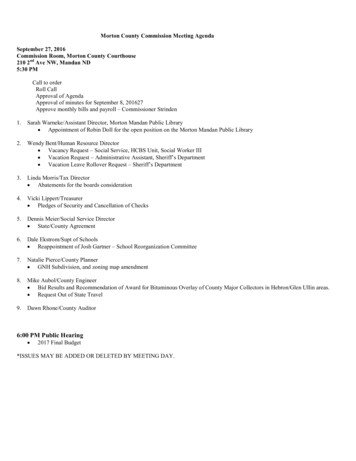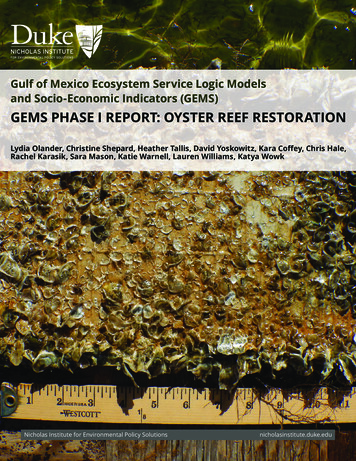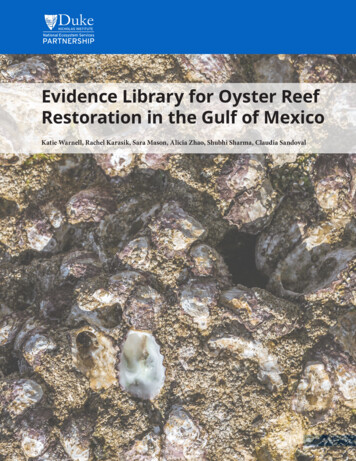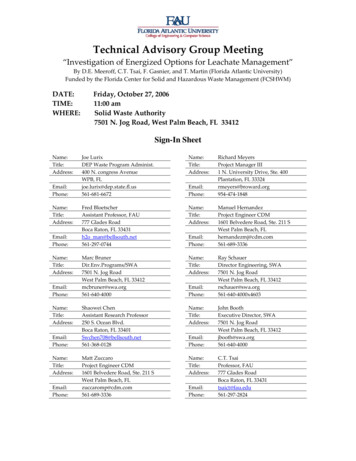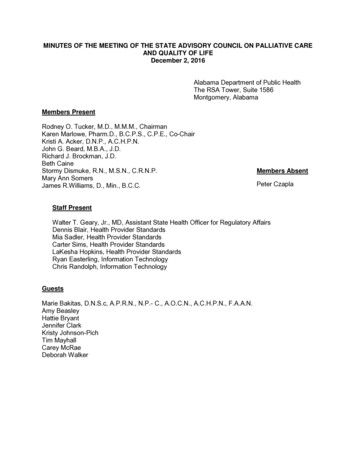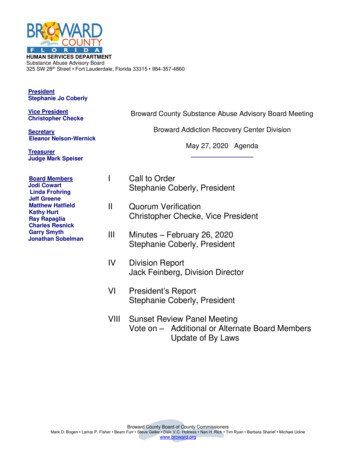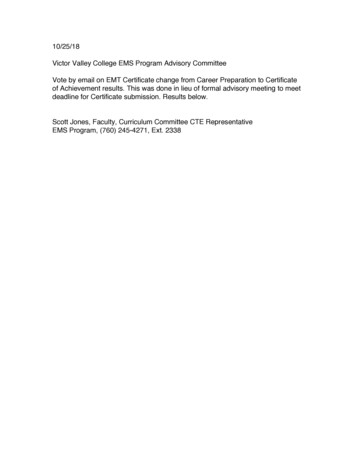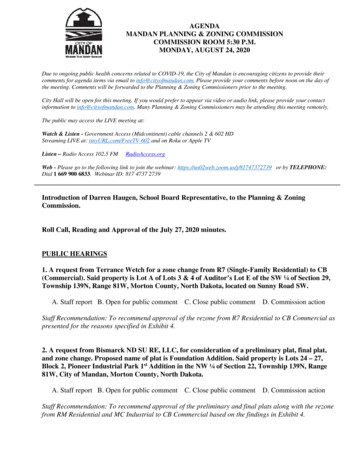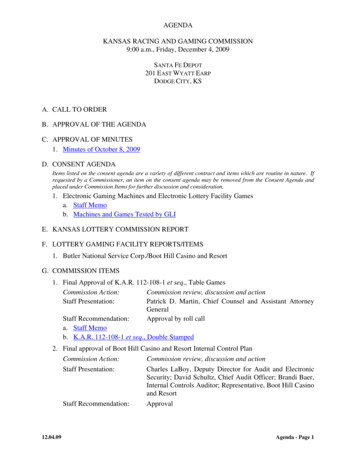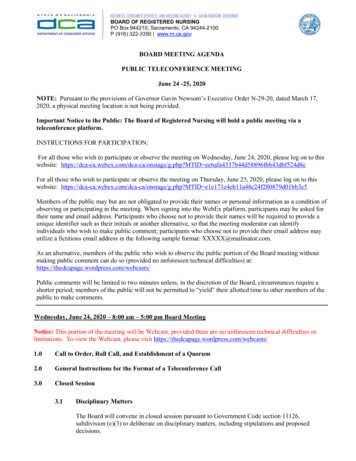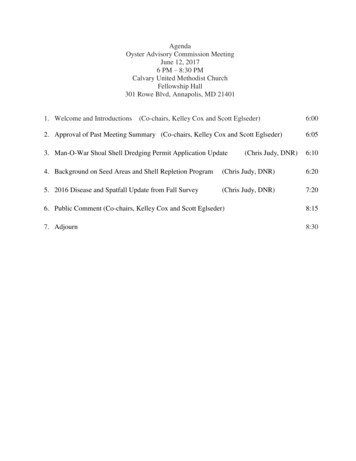
Transcription
AgendaOyster Advisory Commission MeetingJune 12, 20176 PM – 8:30 PMCalvary United Methodist ChurchFellowship Hall301 Rowe Blvd, Annapolis, MD 214011. Welcome and Introductions(Co-chairs, Kelley Cox and Scott Eglseder)6:002. Approval of Past Meeting Summary (Co-chairs, Kelley Cox and Scott Eglseder)6:053. Man-O-War Shoal Shell Dredging Permit Application Update6:10(Chris Judy, DNR)4. Background on Seed Areas and Shell Repletion Program(Chris Judy, DNR)6:205. 2016 Disease and Spatfall Update from Fall Survey(Chris Judy, DNR)7:206. Public Comment (Co-chairs, Kelley Cox and Scott Eglseder)8:157. Adjourn8:30
Meeting SummaryOyster Advisory CommissionJune 12, 2017Meeting SummaryOyster Advisory Commission (OAC) MeetingCalvary United Methodist Church, Fellowship Hall301 Rowe Blvd, Annapolis, MD(6:00 PM – 9:00 PM)June 12, 2017LIST OF ATTENDEESCommissioners Present:Scott Eglseder (Co-Chair)Eglseder Wealth Management Group, Inc.Robert T. BrownMaryland Watermen’s AssociationAllison ColdenChesapeake Bay Foundation (CBF)Ron FithianJeff HarrisonKent County CommissionersNational Oceanic and Atmospheric Administration (NOAA)Chesapeake Bay OfficeTalbot County Watermen’s AssociationBill KilinskiCharles County Watermen’s AssociationDoug LegumDouglas Legum Development Inc.Ken LewisCoastal Conservation Association (CCA)Johnny MautzState DelegateJim MullinMaryland Watermen’s Association (MOA)Deborah ReyState DelegateAnn SwansonChesapeake Bay CommissionSean CorsonCommissioners Unable to Attend:Kelley Cox (Co-Chair)Phillips Wharf Environmental Center (PWEC)J.D. BlackwellDon BoeschKelton Clark38 North OystersUniversity of Maryland Center for Environmental Science(UMCES)Morgan State University (MSU)Steve HersheyState SenatorGreg KempTalbot County Seafood Heritage AssociationState SenatorJim MathiasBen ParksMaryland Watermen, Dorchester CountyAngie SowersUniversity of Maryland Center for Environmental Science(UMCES)U.S. Army Corps of Engineers (USACE), Baltimore DistrictAubrey VincentLindy SeafoodEric SchottSUMMARY1
Meeting SummaryOyster Advisory CommissionJune 12, 2017Other Meeting Attendees Present:Citizen: Mr. Charles Denton, Ms. Jennifer Herzog, Ms. Lani Hummel,Congressman Andy Harris’ Office: Ms. Denise LoveladyCoastal Conservation Association (CCA): Mr. Larry JenningsDelmarva Fisheries Association Inc.: Capt. Robert NewberryDorchester County Council: Mr. Tom BradshawFriends of St. Clements Bay: Ms. Liz CurtzMaginnes Productions: Mr. David MaginnesMaryland Department of Natural Resources: Ms. Jodi Baxter, Mr. Chris Judy, Mr. MitchellTarnowskiMaryland Environmental Service (MES): Ms. Maggie CaveyPhillips Warf Environmental Center: Ms. Carol McColloughSenator Hershey’s Office: Ms. Erika HowardSevern River Association: Ms. Lana KeetlzSt. Mary’s River Watershed Association: Mr. Bob LewisTalbot Watermen Association: Ms. Robin HarrisonSUMMARY2
Meeting SummaryOyster Advisory CommissionJune 12, 2017Handouts: Meeting Agenda May 15, 2017 Draft Meeting Summary Letter – From Mr. Louis Chiarella, National Oceanic and Atmospheric Administration(NOAA), to Ms. Beth Bachur, Baltimore District, Corps of Engineers (USACE), regardingMan-O-War Shoal Shell Dredging Permit and essential fish habitat (EFH). Presentation – DNR Repletion Program: 1960-2006 Handout – Dredged Shell Plantings and Costs: MdDNR 1960-2006 Handout – Maryland Shell and Seed Plantings in Bushels and Dollars: 1986-2008 Presentation – 2016 Maryland Fall Oyster SurveyNote: Meeting agendas, handouts and approved meeting summaries will be available on the OACwebpage: /?com oac&page meetingsAction Items: DNR will provide the OAC with the list of shell deposits that had been provided to theprevious OAC. The OAC recommended that once the restoration tributaries are selected, and prior to thepublic hearing, the County Oyster Committees will be provided with an informationalbriefing and offered the opportunity to provide comment and guidance on the proposal.As the planning process proceeds the County Oyster Committees will continue to beapprised of the management actions underway. The OAC will not meet in August.MEETING SUMMARY:Welcome and Meeting Summary Approval(Mr. Scott Eglseder, Co-chair)Edits to the May meeting summary (provided by Delegate Mautz and Ms. Colden) wereincorporated and the summary was approved by the OAC.Man-O-War Shoal Shell Dredging Permit Application Update(Mr. Chris Judy, DNR)A brief update was provided on the status of the Man-O-War Shoal shell dredging permit. Thestatus is largely the same as last month: the application is still under review by the USACE dueto ongoing ESA and EFH consultations (Endangered Species Act and Essential Fish Habitat),and a decision on the permit is due this summer. Recent progress on the application was a letterfrom NOAA to USACE providing agency comments on the EFH issues. The OAC reviewed thisletter during the meeting. A copy of the letter will be made available on the OAC website. Mr. Fithian asked if NOAA provides comments regarding impacts to EFH for alldredging projects in the Bay including the sediment dredging that occurs in the shippingchannels. He asked why the permit process has taken so long for this specific permit. Hestated that the OAC should be invited to attend USACE meetings held regarding theSUMMARY3
Meeting SummaryOyster Advisory CommissionJune 12, 2017permit. He stated that he believes that the Harris Creek project has been a completefailure since oysters must be continually added to Harris Creek to make it successful. Heasked if the ecological benefits provided by Harris Creek are worth the millions of dollarsspent on the project.o Mr. Corson explained that NOAA provides comments on dredging projects anytime a dredging permit application is filed with USACE. He stated that HarrisCreek project should not be considered a failure. Oysters are being added to theHarris Creek restoration site in order to create different age classes. He explainedthat the project is being conducted to restore oyster habitat and not for harvest.The success of restoration of habitat in Harris Creek can be seen by looking at thefish activity and the formation of vertical reefs. Harris Creek is one of tentributaries in the Chesapeake Bay that have been selected for oyster habitatrestoration projects and it has been determined that the collective ecologicalbenefits to the Bay outweigh the financial expenditures. He noted that HarrisCreek and the dredging of Man-O-War Shoal are not the same issue. Mr. Mullin asked if NOAA provides similar comments on all dredging permits.o Mr. Corson stated that the comments provided were not specific or unique for thisshell dredging permit. NOAA provides a standard consultation on essential fishhabitat for all USACE permits. Mr. Harrison noted the benefit of using shell for restoration and noted that the 100million bushels (estimated total in Man-O-war Shoals) were capable of producing a lot ofrestoration in the future. Mr. Corson clarified that NOAA has suggested that the USACE moves forward with theMan-O-War Shoal dredging permit but with contingencies concerning EFH. Ms. Swanson stated that projects like Tred Avon and Harris Creek should be carefullymonitored to make sure the ecological benefits are worth the financial expenditures. Shealso stated that tracking the benefits of shell from Man-O-War (if the permit is given)should be conducted to determine if it is worth the financial expenditures and loss ofhabitat to Man-O-War.Background on Seed Areas and Shell Repletion Program(Mr. Chris Judy, DNR)Presentation – DNR Repletion Program: 1960-2006Handout – Dredged Shell Plantings and Costs: MdDNR 1960-2006Handout – Maryland Shell and Seed Plantings in Bushels and Dollars: 1986-2008A presentation was provided explaining the DNR Repletion Program that was conducted from1960-2006 and which focused on enhancing the industry and improving harvest. Mr. Judyexplained that the purpose of the presentation was simply to brief the OAC on past managementactions and concepts, given that the Repletion Program has been mentioned at many OACSUMMARY4
Meeting SummaryOyster Advisory CommissionJune 12, 2017meetings but only about half the members were familiar with the program since it pre-dated mostof the member’s involvement with oysters. A second purpose of the presentation was to answerspecific questions the OAC has asked about the program. Mr. Legum asked if DNR is suggesting that Maryland return to a similar RepletionProgram as the program conducted from 1960-2006.o Mr. Judy stated that the purpose of the presentation was only to provide a basicbriefing on the program’s concepts and terminology in order to bring the fullmembership up to speed with this historical program. This information wasrequested by the OAC at past meetings. He added that the three essentialcomponents of the program (abundant shells, high spat sets, and abundantfunding) are no longer available, so returning to such a program of that scalesimply isn’t possible. Mr. Legum stated that the OAC needs to work on recommending the remaining twotributaries and on options for rotational harvest. He noted that funding will be importantfor future work and offered to work on fund raising through the private sector.o Mr. Judy stated that both funding and shell are in short supply which limitsMaryland’s ability to return to a program like the Repletion Program of 19602006. That is not to say that some small component of the repletion plan could notbe part of the OAC’s recommended management plan.o Mr. Legum stated that funding is available and just needs to be sought after. Mr. Fithian thanked Mr. Judy for his informative presentation. He asked how many acreswere planted each year with shells and seed and how large the planted area in HarrisCreek was.o Mr. Judy stated that 300 acres a year, on average, were planted with dredgedshells and about 300 acres a year were seeded. This compares to the Harris Creekproject that is 350 acres (197 acres of the total received substrate and all 350 acresreceived seed) Mr. Fithian noted that during the Repletion Program, 600 acres were planted for 2 milliondollars, compared to all the funding spent in Harris Creek. He stated that he does notbelieve that the high cost of the Harris Creek habitat restoration program is worthwhile.Additionally he stated that Harris Creek can never be used as a seed area again. Delegate Mautz thanked Mr. Judy for his presentation and asked if the Seed Programlasted beyond 2006.o Mr. Judy explained that seed plantings still occur but they are different from thehistoric Seed Program. The current seed program has two components. The firstplants hatchery seed from a land-based hatchery. It produces seed oysters usinghatchery technology, not using State Seed Areas and natural seed from MarylandSUMMARY5
Meeting SummaryOyster Advisory CommissionJune 12, 2017as in the historic program. The second component buys and plants natural seedfrom Virginia.o Mr. Fithian added that the current program is on a much smaller scale than thepast Repletion Program. Delegate Mautz asked if the plan was to reintroduce the Repletion Program if the Man-OWar Shoal permit were approved.o Mr. Judy explained that historically, 5 million bushels of shell a year were plantedfor the Repletion Program. If the Man-O-War Shoal permit were to be approved,it would provide 5 million bushels but over 5 years. Additionally, the 5 millionbushels will be divided among fisheries, sanctuaries, and aquaculture. With only 5million bushels of shell divided three ways over 5 years, Maryland would not beable to return to the program simply because there would not be enough shell.Although there are other options for areas to shell dredge, each option comes withits own set of permitting and environmental issues. Traditional active dredgingsites have been exhausted of shells. He suggested that a smaller version of someaspect of the Repletion Program could possibly be instituted if shells and fundingwere available: perhaps one Seed Area could be created. Delegate Mautz noted that if there was no available shell then there could be noRepletion Program. He asked how the program differed from the tributary-wide oysterhabitat restoration program.o Mr. Judy explained that the Repletion Program was focused on harvest bars, withthe goal of enhancing the oyster harvest. The program was not established tospecifically provide ecosystem services but this result did occur because of thenew oysters added to the Bay. Though, this result was short-term due to harvest.The tributary-wide oyster restoration program of today is focused on ecologicalservices and occurs in areas closed to the fishery. Mr. Brown stated that a seed area is needed. He did not feel Harris Creek was the greatsuccess that the OAC has been told it would be. He added that Harris Creek is 350 acresand not entirely planted.o Mr. Corson explained that all 350 acres of Harris Creek have been planted. Mr. Brown stated that the successes in Harris Creek are being handpicked to show themost successful areas. Mr. Corson stated that the measurement of the effectiveness of the Harris Creek oysterhabitat restoration project is not simply a matter of scientific efficiency and funding. Thesanctuaries have been located and designed to have a spillover effect. When successful,the sanctuaries create larvae for oyster habitat downstream. Mr. Corson asked if DNRwas posing a question to the OAC by sharing the Repletion Program presentation.SUMMARY6
Meeting SummaryOyster Advisory CommissionJune 12, 2017o Mr. Judy explained that DNR is not posing any question to the OAC, or seeking arecommendation, but rather clarifying questions that OAC members hadpreviously asked about how the program once operated and what its goals andresults were. Ms. Colden noted that the Repletion Program did not sustain the commercial harvest. Mr. Judy agreed and mentioned that this point was made in earlier slides. He pointed outthat disease had a large impact on the sustainability of harvest via the program. Theprogram was effective at boosting harvest for decades but then results were compromisedby MSX and Dermo that surged in the mid 1980’s. The program can be viewed in twomain time periods: one before the mid 1980’s and one after the mid 1980’s. The first sawlow to no disease issues, excellent survival and significant results from both shell andseed plantings. The latter time period saw high mortality and declining harvests even withthe program. In this latter time period, certain areas of the Bay still experienced elevatedharvests due to the program, but the overall State-wide result toward the end of theprogram was record low harvests for the industry. The Repletion Program wascompromised near the end, but was not a waste of funding throughout the entire span of47 years because it resulted in an increase in the commercial harvest as it was intended todo. Ms. Colden explained that she does not believe the program had been a waste of fundingbut she noted that the accomplishments of the program have since broken down and donot produce the same level of added benefit. Mr. Harrison stated that the program started in 1960 as a form of aquaculture working tobuild reefs that are still producing oysters. The waterman participated and spent 6-8weeks a year assisting with the Repletion Program. Mr. Harrison stated that it gave thewatermen something to do for those 6-8 weeks rather than immediately beginning crabseason. Mr. Harrison asked DNR if there was any remaining shell in areas that werepreviously dredged.o Mr. Judy explained that shells still exist in the bottom of the prior dredge cutsbecause the dredge was limited in length and couldn’t extract all the shells. Alonger dredge could possibly get those shells but they are now under about 15’ ofsediment because the shell dredge at the time redeposited silt and shell “fines”(grit) back into the cuts. Mr. Kilinski thanked Mr. Judy for the presentation and stated that he was amazed to seethe numbers and the benefits of the Repletion Program in a quantitative way. He notedthat the program had been effective and he suggested that the OAC recommend thecreation of a small scale Repletion Program as part of the OAC’s management planrecommendations to DNR. Mr. Legum stated that regardless of any of the Commissioner’s opinions of the HarrisCreek tributary oyster habitat restoration project, the tributary work has already beenconducted and it is now an oyster restoration tributary under federal law. He noted thatSUMMARY7
Meeting SummaryOyster Advisory CommissionJune 12, 2017the OAC needs to work on recommendations for the two remaining tributaries and for amanagement program, including rotational harvest, before there is no federal fundingavailable to assist with oyster restoration efforts. Mr. Mullin asked if moving seed from one area to another would also move disease. Hestated that disease was to blame for the decline in oyster harvest, not over harvest.o Mr. Judy stated that infected seed was moved at times during the program andtherefore disease was also moved. He added that disease was a major contributorto the decline in harvest. However, moving seed is not the only method by whichdiseases spread – they spread on their own without the aid of a boat transportingthem – meaning that even without the Seed Program, diseases would still havecompromised the harvest during the droughts post-mid 1980’s. Mr. Fithian suggested that someone or some organization be tasked with identifying othershell dredging options and report back to the OAC. Ms. Colden recommended examining sub-bottom profiling and vibracore data to evaluateother shell dredging options.o Mr. Judy replied that vibracore samples were taken by DNR in many areas about20 years ago and locations where buried shell deposits exist are well known. Mr. Brown stated that there is an abundance of shell in the Bay but the shell is located inareas of controversy regarding issues such as the protection of (striped bass) spawningareas. Mr. Lewis noted that extensive information regarding shell deposits in the ChesapeakeBay had been provided to the first OAC around 2006. He suggested that this informationbe presented to the current OAC. Ms. Swanson requested that the OAC return to the original assignments they had beengiven by DNR. She asked for DNR to provide information on sizable shell deposits thatcould be options for shell dredging. She reminded the OAC that they are there to considerboth the ecological and economic benefits provided by the oysters. Ms. Swanson thankedMr. Judy for the information he provided regarding the Repletion Program. Mr. Eglseder requested that DNR provide the OAC with the existing list of shell depositsthat was mentioned by Mr. Lewis.2016 Disease and Spatfall Update from the Fall SurveyPresentation – 2016 Maryland Fall Oyster Survey(Mr. Chris Judy, DNR)Information was presented to the OAC on the data and analysis from the 2016 Fall OysterSurvey. Mr. Fithian stated that the 2010-2012 data suggests that if the Repletion Program hadcontinued then Maryland would have seen the numbers double and continue to increase.SUMMARY8
Meeting SummaryOyster Advisory CommissionJune 12, 2017o Mr. Judy stated that even though shells from the Repletion Program would likelyhave acquired a spat set, the Fall Survey spat index would not have risen becauseit is based on samples from natural oyster bars, not areas planted with shell.Shelled areas aren’t part of the spat index. Mr. Harrison asked if the 43 bars evaluated for disease included Harris Creek. He askedif DNR is sampling in areas where spat on shell has been placed or if they are samplingjust areas that have received natural spat set.o Mr. Tarnowski explained that Harris Creek was evaluated for disease in additionto the standard 43 bars. The fall survey has 43 pre-set bars that are sampled fordisease and spa
Scott Eglseder (Co-Chair) Eglseder Wealth Management Group, Inc. Robert T. Brown Maryland Watermen’s Association Allison Colden Chesapeake Bay Foundation (CBF) Ron Fithian Kent County Commissioners Sean Corson National Ocean
